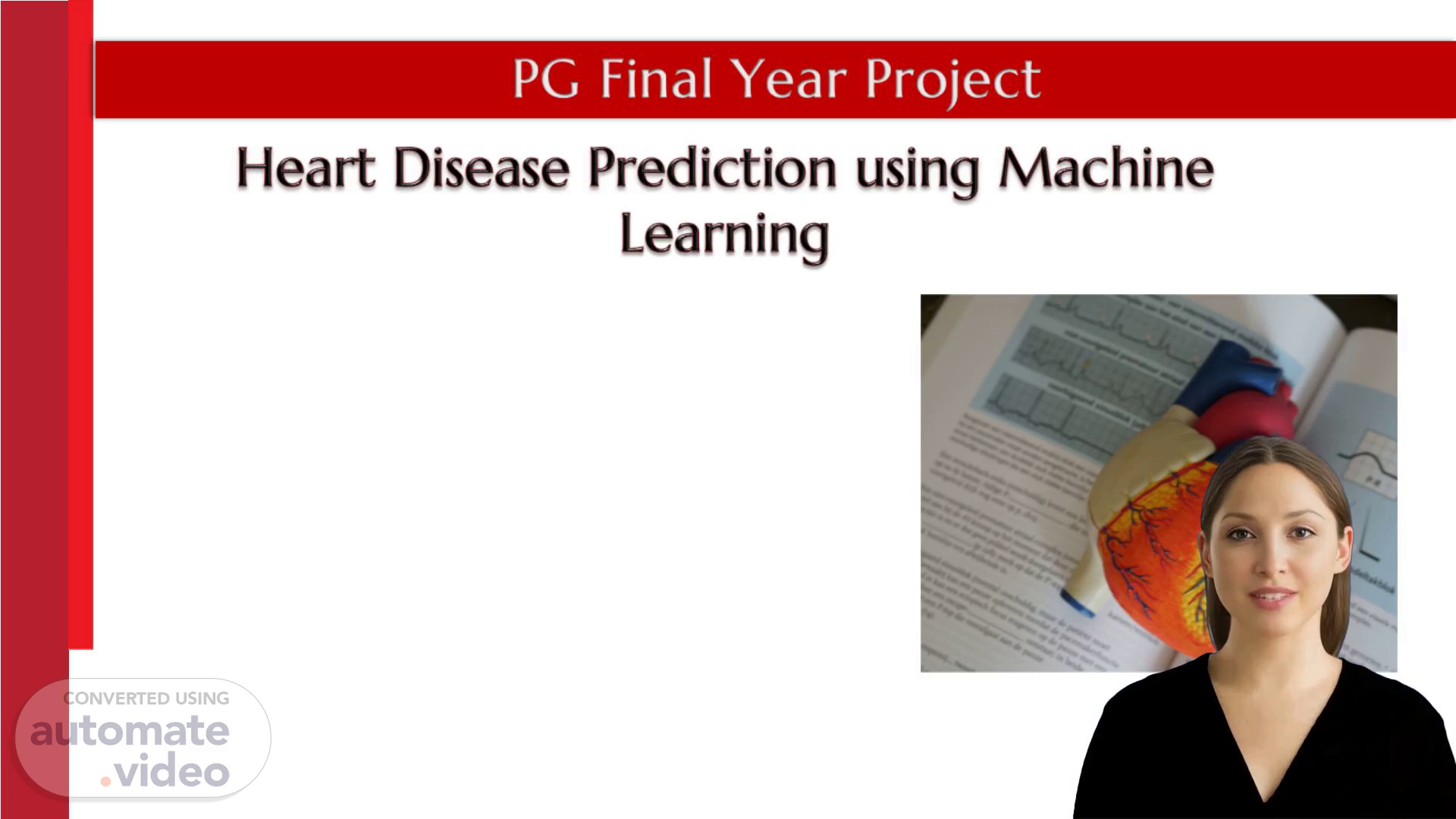
PowerPoint Presentation
Scene 1 (0s)
[Virtual Presenter] Good evening everyone. It's a pleasure to introduce the project that I have been working on Heart Disease Prediction using Machine Learning. I'll briefly outline the project here then discuss it in detail over the course of the presentation..
Scene 2 (15s)
[Audio] The slide will highlight the aim and objectives of the project. The aim is to create a predictive model using machine learning techniques that can classify if a person has heart disease or not. The objectives of the project are to explore and understand the dataset and its features apply feature selection techniques use machine learning algorithms such as K Nearest Neighbors and Random Forest Classifier for prediction evaluate the models' performances and provide insight into the importance of early detection of heart disease using data science approaches..
Scene 3 (53s)
[Audio] Heart disease is a major concern in global health causing millions of fatalities annually. Early diagnosis is paramount for successful treatment and avoidance of grave difficulties. By harnessing machine learning to forecast heart disease medical professionals can gain a powerful aid to prioritize patient care and make informed decisions. Employing data-driven methods can significantly enhance diagnosis accuracy while aiding in lessening healthcare expenditure ultimately resulting in improved patient health outcomes..
Scene 4 (1m 29s)
[Audio] Machine Learning has become an increasingly influential tool in medical diagnosis in recent years. This slide presents a selection of research that explores the use of Machine Learning for detecting heart disease. A range of Machine Learning techniques including Linear Regression Support Vector Machine K-Nearest-Neighbors Random Forest Decision Tree and Gradient Boosting have been utilized. Results have not been fully satisfactory implying there is still much progress to be made. To move forward designed prediction models to counteract overfitting in Machine Learning models is necessary..
Scene 5 (2m 5s)
[Audio] Two research papers that implemented machine learning algorithms for heart disease prediction are presented in this table. With the intention to improve accuracy and efficiency of the models both papers employed advanced machine learning algorithms. Logistic Regression K Nearest Neighbors and Random Forests were used in the first one and Support Vector Machines in the second one. This highlights the limitations of traditional clinical methods and the necessity of more efficient diagnostic systems..
Scene 6 (2m 38s)
[Audio] I have chosen to work on predicting heart disease using machine learning for my final year project. Data collection for this project involves gathering information such as age blood pressure cholesterol levels and more. I then need to clean and preprocess the data to analyze correlations and select significant features. To classify the data I will use K Nearest Neighbours and Random Forest Classifier algorithms. For assessing the performance of the models I will apply cross-validation techniques. To optimize the predictive accuracy and interpret the results I will fine-tune the model parameters to explore the factors which help with heart disease prediction..
Scene 7 (3m 18s)
[Audio] I used a variety of different libraries for my project namely Matplotlib Numpy Pandas Seaborn and Scikit Learn. Data preparation involved cleaning selecting features and processing. Machine Learning models utilized were the KNeighbors Classifier and the Random Forest Classifier. Visualization techniques used to analyze the data included a correlation heatmap K-N-N scores plot and countplot of target classes..
Scene 8 (3m 49s)
[Audio] We start by Loading and exploring the dataset creating a correlation matrix as well as data processing. Visualising the correlations in a heatmap and KNN Scores plot follows. For model training we train both the KNN Classifier and the RandomForest Classifier. Finally we evaluate both the models and get the accuracies..
Scene 9 (4m 12s)
[Audio] Data preparation is the initial step in the workflow of the Heart Disease Prediction System. This process involves loading and exploring the dataset creating a correlation matrix and pre-processing the data. The next step is model training where the dataset is split accordingly and K-Neighbors and K-Nearest Neighbors Classifiers are deployed. The final step is model evaluation where the accuracy of the K-Neighbors and Random Forest Classifiers are tested. This workflow helps to have a reliable prediction of heart disease..
Scene 10 (4m 45s)
[Audio] Creating a machine learning model to predict heart disease has multiple advantages. Early identification and prediction of the illness allows interventions to be taken in time leading to better patient results. Additionally healthcare resources can be focused on screening and diagnosis more efficiently. Additionally this endeavor also shows the potential of machine learning in healthcare for predictive analytics and decision support. Nonetheless certain difficulties need to be taken into consideration for instance managing unbalanced datasets for secure performance addressing the complexity of utilizing machine learning models in an clinical setting protecting sensitive healthcare data and including domain knowledge to strengthen model interpretability and pertinence..
Scene 11 (5m 35s)
[image]. [image]. [image] A close up of a sign Description automatically generated.